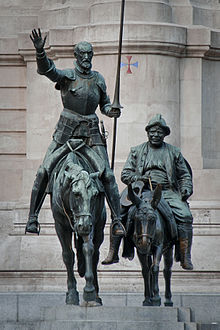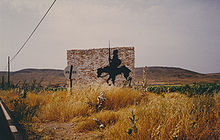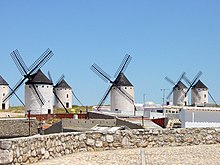Don Quixote
![]()
The title of this article is ambiguous. For other meanings, see Don Quixote (disambiguation).
Don Quixote [![]()
![]() ˈdoŋ kiˈxɔte] (Don Quixote in old spelling; Don Quixote [kiˈʃɔt] in French orthography, sometimes also used in German) is the common name for the Spanish-language novel El ingenioso hidalgo Don Quixote de la Mancha by Miguel de Cervantes, translated The Sensible Junker Don Quixote of La Mancha, and also the name of the protagonist. The first part was published in 1605, the second in 1615 under the title Segunda parte del ingenioso caballero don Quixote de la Mancha.
ˈdoŋ kiˈxɔte] (Don Quixote in old spelling; Don Quixote [kiˈʃɔt] in French orthography, sometimes also used in German) is the common name for the Spanish-language novel El ingenioso hidalgo Don Quixote de la Mancha by Miguel de Cervantes, translated The Sensible Junker Don Quixote of La Mancha, and also the name of the protagonist. The first part was published in 1605, the second in 1615 under the title Segunda parte del ingenioso caballero don Quixote de la Mancha.
Don Quixote is a reader addicted to his chivalric novels, who seems unable to distinguish between fiction and truth. He believes himself to be a proud knight who is supposedly fated to undertake one daring adventure after another. He mounts his rickety horse Rosinante and fights windmills, among other things. Faithfully riding at his side is the only seemingly naive squire Sancho Panza (also: Sancho Panza), trying to save his master from worse misfortune. Mostly the episodes end with Don Quixote being beaten up and appearing less gloriously as the "Knight of the Woeful Countenance". In the second part, presented in 1615, the - still impoverished - landed nobleman Don Quixote has become a literary celebrity.

Don Quixote and Sancho Panza. Bronze figures at the monument to Cervantes (background) in Madrid.
Background
Among the most popular reads of the late Middle Ages were the romances of chivalry, especially the novel Amadis of Gaul. Increasing demand from readers led to a flood of new sequels, in which ever more fantastic, implausible adventures were described, which - according to the educated of the time - clouded the brains of the readers.
This is where the author comes in. His Don Quixote is not only meant to parody the romances of chivalry, but also to demonstrate how their excessive reading robs the mind. Cervantes claims to have taken the story itself from the writings of a (fictitious) Arab historian, Cide Hamete Benengeli, whose Arabic name contains a "stag" as well as "Cervantes".
The hometown of Don Quijote
According to a popular theory, Cervantes alludes in the opening sentence to the town of Argamasilla de Alba in the province of Ciudad Real, where he is said to have spent some time in prison, although this is not proven.
According to a study by the Complutense University in Madrid, Villanueva de los Infantes, a good 40 kilometres south of Argamasilla de Alba, is a possible starting point for Don Quixote's rides because of its geographical location.
In the last chapter of Part Two, Cervantes writes that the fictional narrator appearing in the novel did not name the protagonist's hometown,
"... por dejar que todas las villas y lugares de la Mancha contendiesen entre sí por ahijársele y tenérsele por suyo, como contendieron las siete ciudades de Grecia por Homero."
"... to allow all the towns and villages of La Mancha to compete over which place may claim him as its son and count him among its own, just as those seven cities of Greece once contended over Homer."

The home of Don Quixote

Windmills at the Ruta de Don Quijote
Media
- Don Quixote de la Mancha. Radio play. Radio play adaptation: Walter Andreas Schwarz. Directed by Ulrich Lauterbach. Narrators among others: Walter Richter, Willy Birgel. Recorded 1962. 6 CD. Dhv, 2003 ISBN 3-89940-144-1.
- Adventure classics - Treasure Island, Sea Wolf, Leatherstocking ... 2 CD. BSC Music, prudence 398.6619.2 (with music from the ZDF four-parter).
- Original Broadway cast of the musical version The Man of La Mancha CD 1965, (CD re-recording from 2002 with Brian Stokes Mitchell as Don Quixote, Marie Elizabeth Mastrantonio as Aldonza and Ernie Sabella as Sancho Panza via download on the web; German language version (Vienna) with Josef Meinrad, as well as a recording with Plácido Domingo as Don Quixote and Julia Migenes as Aldonza).
- Miguel de Cervantes: Don Quixote de la Mancha. Romances y Músicas, Montserrat Figueras, Hespèrion XXI, La capella reial de Catalunya, Jordi Savall. Translated into 7 languages. 2 CDs with music of the period and thematically related to the novel.
Questions and Answers
Q: Who wrote Don Quixote?
A: Miguel de Cervantes.
Q: In how many parts was Don Quixote published and in what years?
A: Don Quixote was published in two parts, in 1605 and 1615.
Q: In which language was Don Quixote originally written?
A: Don Quixote was first written in Spanish.
Q: Who translated Don Quixote into English and when?
A: Don Quixote was translated into English by Thomas Shelton. It is unclear when precisely the translation was completed.
Q: Why is Don Quixote considered by many scholars to be the first modern novel?
A: Don Quixote is considered the first modern novel mainly due to its self-consciousness and metatextual elements, among other factors.
Q: Who is Don Quixote?
A: Don Quixote is the main character of the novel of the same name. He is a middle-aged man who has gone insane and believes he is a knight named Don Quixote.
Q: What is Don Quixote's most famous adventure in the book?
A: Don Quixote's fight with the windmills is his most famous adventure. He sees the windmills as giants and charges them, only to be knocked off his horse.
Search within the encyclopedia